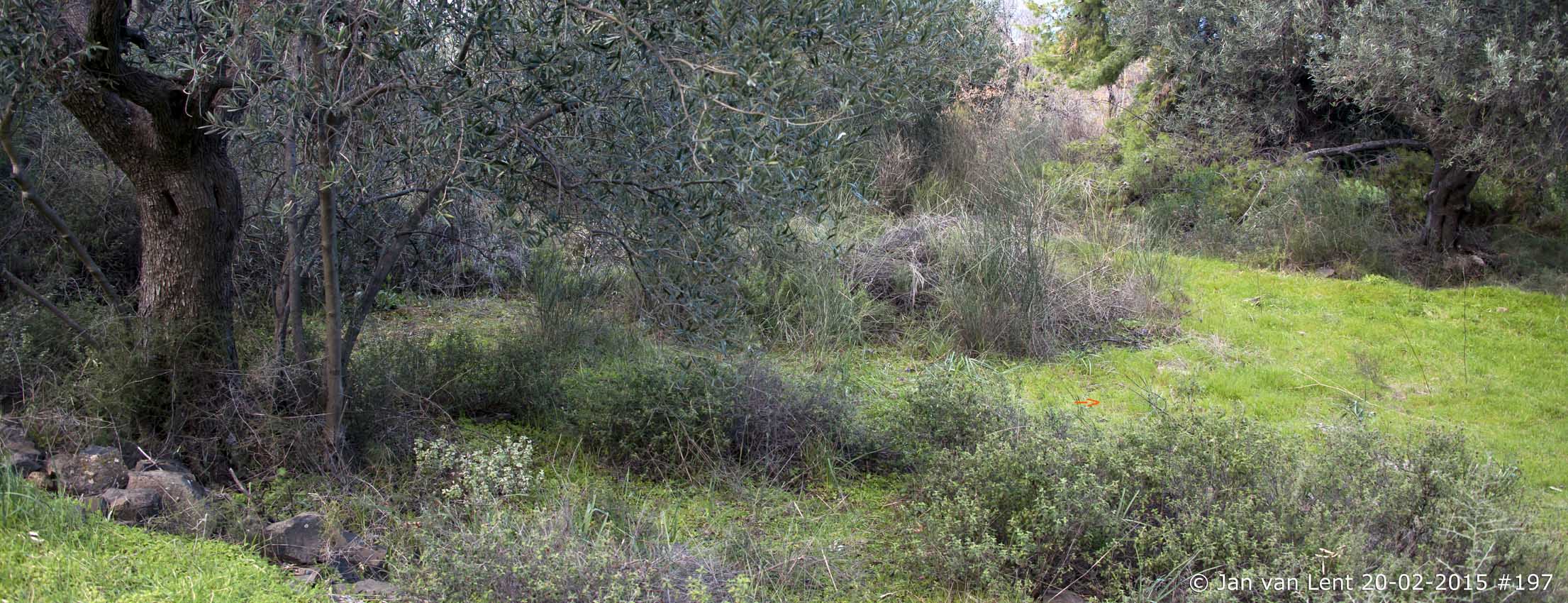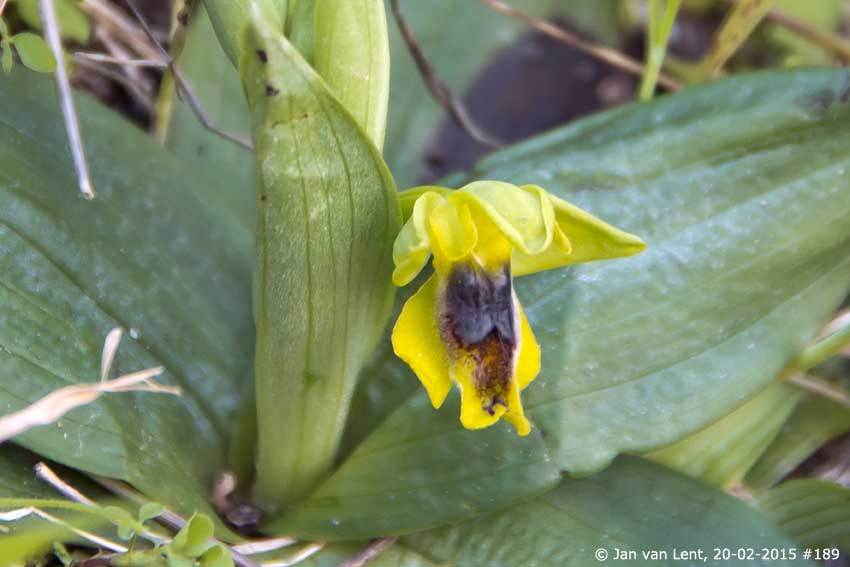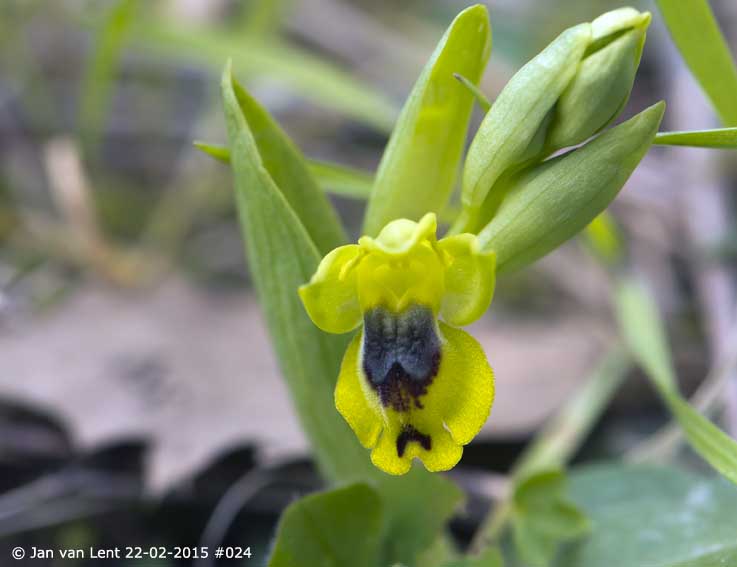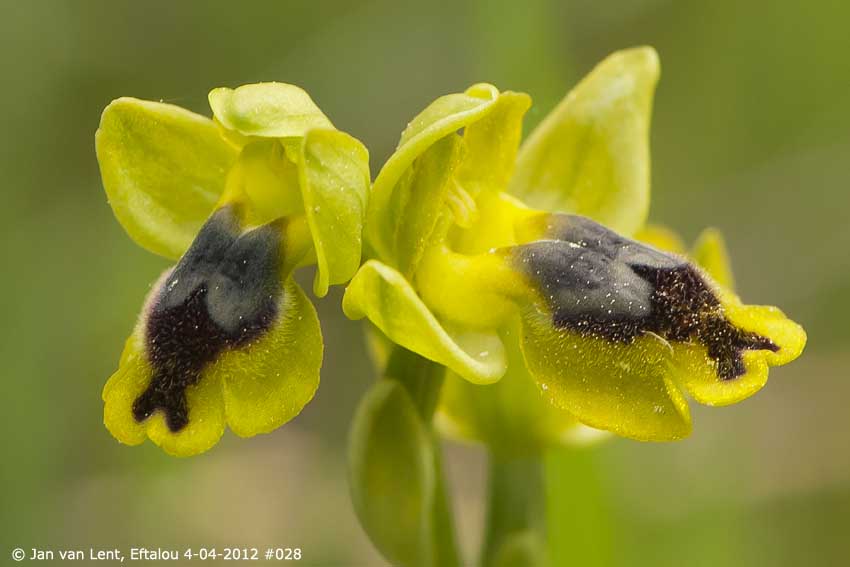Habitat: Eftalou (Mno)
Habitat 1e Ophrys sicula Eftalou © Jan van Lent, 20-02-2015 #197
Ophrys sicula TINEO 1817 (KEW) or 1846 (IPNI) or
Ophrys galilaea H. FLEISCHMANN & BORNMULLER 1923.
Homotypic* synonyms:
Ophrys lutea var. sicula (TINEO) NYMAN 1882;
Ophrys lutea f.* sicula (TINEO) SOÓ 1927;
Ophrys fusca var. sicula (TINEO) E.G. CAMUS & A. CAMUS 1928;
Ophrys lutea ssp. sicula (TINEO) SOLDANO 1993.
Heterotypic* synonyms:
Ophrys lutea ssp. galilaea (H. FLEISCHMANN & BORNMULLER) SOÓ 1926
Ophrys lutea ssp. sicula (Todaro) O. & E. DANESCH;
Ophrys sicula ssp. galilaea (H. FLEISCHM. & BORNM.) H.F. PAULUS & GACK 1990;
Ophrys sicula (TINEO) NYMAN, 1882;
Ophrys lutea var. minor (TODARO) GUSSONE;
Ophrys lutea ssp. minor (TODARO) O. & E. DANESCH.
Ophrys minor (TODARO) H.F. PAULUS & GACK.
Ophrys galilaea H. FLEISCHMANN & BORNMULLER 1923, typus: Israel 21-04-1892;
Ophrys minor ssp. galilaea (H. FLEISCHM. & BORNM.) H.F. PAULUS & GACK.
1e Ophrys sicula, Eftalou © Jan van Lent 20-02-2015 #189
HABITAT: This year the first ‘yellow’ Ophrys flowered in a different way compared to earlier years: both flowered directly out of the stem. Normally the stem grows until a few centimeters high and then the flowers open. This year the flowers didn’t wait for the stem to grow higher, they just appeared almost from the base of the stem or from the rosette.
2e Ophrys sicula, Eftalou © Jan van Lent 22-02-2015 #024
NAMES: In this – and earlier – blogs I usually use the shortest version of an orchid name; as in this case Ophrys sicula or only ‘sicula’ instead of a full name like: Ophrys lutea ssp. sicula (Tod.) Dan. I realise that this can lead to confusion. Clearly I don’t know – and I don’t mind when I meet an orchid in the field – if an orchid is a ‘real’ species, a subspecies or just a variety, that’s for others to decide; there are ‘wars’ between orchid researchers about this – and almost every other – orchid subject. But I get sad when an orchid I and almost all orchid researchers and orchidologists know today under the name ‘sicula’ – the early flowering, small, yellow Ophrys which is related to Ophrys lutea, has to be renamed ‘galilaea’. Who says so? Well, Pedersen, H.Æ. & Faurholdt, N. (2007) & Kew Gardens at first, now (the proposals of) HENNECKE M. & MUNZINGER S. (2014) also try to rename this orchid. I understand why some orchidologists wanted to use the name ‘minor’ because it is a small version of the bigger Ophrys lutea. But ‘galilaea’? Oh yes, wasn’t that the subspecies or even variety which was found in 1892 in Palestine and described by FLEISCHMANN & BORNMULLER in 1923? And what has this species or even the proposed name to do with Ophrys sicula from – for instance – Lesvos? ‘Tipota’ we say here in Greece, nothing. The only ‘real’ Ophrys (lutea ssp) galilaea photographed was I think from Israel, Zikhron ( R. PETER on 12-02-1983) and in 2012 maybe the photograph from MUNZINGER S, made in Sicily in 2012. And that was also totally different from the Ophrys sicula or even from the Ophrys phryganae growing on Lesvos. Also BAUMANN’s photograph of Ophrys lutea ssp. galilaea made in N-Israel, Haifa on 14-03-1994 is not in heart and soul a real ‘sicula‘; his photograph of Ophrys lutea ssp. minor was closer to it. I could publish a book about all the names and written ‘tangle’ of names this small Small Yellow Mirror Orchid has been called through the years and centuries. ‘Lutea’ was the most common, ‘sicula’ a good second; ‘galilaea’ the third and ‘fusca’ & ‘minor’ last. And then I don’t include all the homo- and heterotypic synonyms (30), hybrids and variations (12) which are described. So let me make a list of the Ophrys lutea taxa in the recent Mediterranean – Greece – Aegean islands orchid literature taking 15 years ago as the starting point:
KREUTZ, C.A.J.: ‘Die Orchideen der Türkei’, (1998).
Ophrys phryganae J. DEVILLERS-TERSCHUREN & P. DEVILLERS 1991;
Ophrys sicula TINEO 1846;
KREUTZ, C.A.J.: ‘Die Orchideen von Rhodos, Karpathos’, (2002).
Ophrys phryganae J. DEVILLERS-TERSCHUREN & P. DEVILLERS 1991;
Ophrys sicula TINEO 1846;
KREUTZ, C.A.J.: ‘Die Orchideen von Zypern’, The Orchids of Cyprus’, (2004).
Ophrys melena (RENZ 1928) PAULUS & GACK 1990;
Ophrys sicula TINEO 1817;
KRETZSCHMAR, H. & G. & ECCARIUS, W.: ‘Orchids Crete & Dodecanese’, (2004).
Ophrys phryganae J. DEVILLERS-TERSCHUREN & P. DEVILLERS 1991;
Ophrys sicula TINEO 1846;
DELFORGE, P.: ‘Orchids of Europe, North Africa and the Middle East’, (2005).
The Ophrys Lutea group:
Ophrys lutea CAVANILLES 1753;
Ophrys phryganae J. DEVILLERS-TERSCHUREN & P. DEVILLERS 1991;
Ophrys sicula TINEO 1846;
Ophrys melena (RENZ 1928) PAULUS & GACK 1990;
The first ones who came up with the name ‘galilaea’ again were:
BAUMANN H./KÜNKELE S./LORENZ R.: ‘
Orchideen Europas mit angrenzenden Gebieten’, (2006).
Ophrys lutea CAV. subsp. lutea;
Ophrys lutea subsp. galilaea (H. FLEISCHMANN & BORNMULLER 1923) SOÓ;
Ophrys lutea subsp. laurensis (GENIEZ & MELKI) KREUTZ;
Ophrys lutea subsp. phryganae (DEVILLERS-TERSCHUREN & DEVILLERS) MELKI;
Ophrys lutea subsp. melena RENZ;
Ophrys lutea subsp. minor (Tod.) O. & E. DANESCH;
Ophrys lutea subsp. murbeckii (H. FLEISCHM.) SOÓ.
This is interesting because the authors describe the differences between ‘minor’ and ‘galilaea’: Subsp. minor (lip 8-11 x 8.5-10mm, yellow border 2-2.5mm) distinguish itself from subsp. galilaea (lip 8.5-10.5 x 7.5-9.5mm, yellow border at the side 1.8-2.7mm, down 04-1mm) by a bigger lip… and the pollinator is also different: Subsp. minor should be pollinated by Andrena hesperia and subsp. galilaea by Andrena taraxaci.
PEDERSEN H./FAURHOLDT N.: ‘Ophrys, the bee orchids of Europe’, (2007).
Ophrys lutea CAV. subsp. lutea, synonym = O. phryganae J. DEVILLERS-TERSCHUREN & P. DEVILLERS 1991.
Ophrys lutea CAV. subsp. galilaea (H. FLEISCHMANN & BORNMULLER) SOÓ 1926;
Ophrys lutea CAV. subsp. melena RENZ.
KARATZÁS G. & A.: ‘Orchidées, agrioloúlouda tis Lésvou’, (2008).
Ophrys sicula TINEO;
Ophrys phryganae J. DEVILLERS-TERSCHUREN;
ANTONOPOULOS Z.: ‘The bee orchids of Greece’, (2009).
The Ophrys Lutea group:
Ophrys lutea CAVANILLES 1753;
Ophrys phryganae J. DEVILLERS-TERSCHUREN & P. DEVILLERS 1991;
Ophrys sicula TINEO;
Ophrys melena (RENZ) PAULUS & GACK 1990;
PETROU, PETROU & GIANNAKOULIS: ‘Orchids of Greece’, (2011):
Ophrys lutea CAVANILLES subsp. lutea;
Ophrys lutea subsp. phryganae (DEVILLERS-TERSCHUREN & DEVILLERS) MELKI.
Ophrys lutea subsp. minor (Todaro) O. & E. DANESCH. = syn. of O. lutea subsp. sicula;
Ophrys lutea subsp. melena RENZ.
TAYLOR, M.: ‘Revised illustrated checklist Orchids of Chios, Inouses & Psara’, (2012).
Ophrys sicula TINEO 1846;
Ophrys phryganae J.D. TERSCHUREN & DEVILLERS 1991.
ROMOLINI, R. & SOUCHE, R.: Ophrys d’Italia (2012):
Ophrys lepida S.MOINGEON & J.-M. MOINGEON 2005;
Ophrys archimedea P. DELFORGE & M. WALRAVENS 2000;
Ophrys sicula TINEO 1846;
Ophrys corsica SOLEIROL ex G. FOELSCHE & W. FOELSCHE 2002;
Ophrys lutea CAVANILLES 1753;
In the ARTICLES:
DEVILLERS, P., BAETEN, F., DEDROOG, L., DEVILLERS -TERSCHUREN, J. & FLAUSCH, A. ‘Orchids of Lesbos : Distributional and Biogeographical Notes.’ Natural. belges 91 (Orchid. 23): 206-245. 2010.
Group of Ophrys lutea:
Ophrys sicula TINEO (s.l.)
‘The plants (of Ophrys lutea collectives) we saw on Lesbos during our three visits, in spite of a rather large spectrum of altitude-corrected flowering dates, appeared to belong to a single taxon clearly referable to O.sicula s.l. in view of its consistently flat labellum. In detail, however, these plants are quite different from those we have seen in Sicily, peninsular Italy, the Dalmatian archipelago, the Ionian Islands and continental Greece.
The Lesbos plants also have, in general, a very broad yellow margin to a labellum that curves up at the rim. They certainly belong to a unit that is specifically distinct from Italo-Sicilian and continental Greek populations. The limits of its range and thus the existence of names to be applied to it remain to be analyzed. Ophrys sicula s.l. is the most widespread Ophrys on the island and we have seen small to medium-sized stations in most of the south-eastern quadrant and in the Andissa-Eresos corridor in the west.’
HENNECKE M. & MUNZINGER S. (2014): Die neue systematische Gliederung der Gattung Ophrys: subgenus Ophrys section Pseudophrys. Ber. Arbeidskrs. Heim. Orchid. 31 (1): 99-126. Untersektion Luteae:
Ophrys lutea Cav. 1793
Ophrys galilaea H. FLEISCHMANN & BORNMULLER 1923:
‘”Sicula” is according to BAUMANN & KÜNKELE (1986) a synonym of Ophrys lutea subsp. minor, and by this they meant a small but characteristic ‘”lutea“, which frequently occurs in Sicily: labellum circle-round, middle- and side lobes overlapping or so close together, that – from above – it looks like it doesn’t have a opening between the lobes. Front of the middle lobe always yellow. It is a variety of the nominative form, only smaller, otherwise identical.’
Oph. sicula Eftalou © Jan van Lent 4-04-12 #028
BOTTOM-LINE: There is a lot written about the name of this small Ophrys lutea member, the most used is Ophrys sicula. I don’t know where HENNECKE & MUNZINGER went to see ‘their’ Ophrys galilaea but I don’t think it was Israel or Lesvos. Here on Lesvos we have ‘only’ the above described ‘minor’ variety from BAUMANN & KÜNKELE and of course Ophrys phrygana. Also all the other authors – see list above – just described this ‘minor’ variety. I think HENNECKE & MUNZINGER - like PEDERSEN & FAURHOLDT – were far away when they renamed this orchid, maybe even in another land…
Jan van Lent, Lesvos 27-02-2015.
Rolling Stones: ‘In Another Land’ (1967).
https://www.youtube.com/watch?v=lucNNRP7vQU
*f. = forma (form)
*Homotypic (literally “with the same type”. In botanical nomenclature a homotypic synonym (or nomenclatural synonym) is a synonym that comes into being through a nomenclatural act.
*Heterotypic (literally “with a different type”. In botanical nomenclature a heterotypic synonym (or taxonomic synonym) is a synonym that comes into being when a taxon is reduced in status (“reduced to synonymy“) and becomes part of a different taxon.




